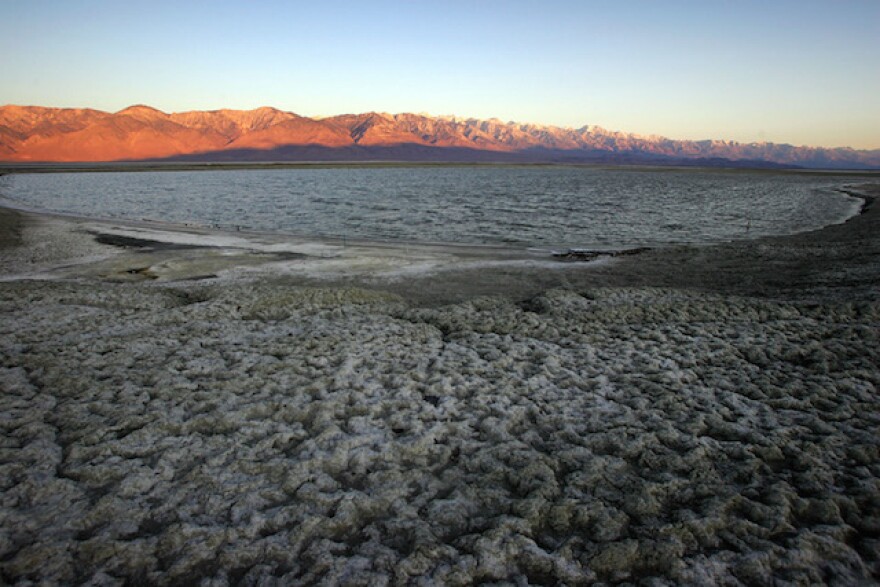Truth matters. Community matters. Your support makes both possible. LAist is one of the few places where news remains independent and free from political and corporate influence. Stand up for truth and for LAist. Make your year-end tax-deductible gift now.
This is an archival story that predates current editorial management.
This archival content was written, edited, and published prior to LAist's acquisition by its current owner, Southern California Public Radio ("SCPR"). Content, such as language choice and subject matter, in archival articles therefore may not align with SCPR's current editorial standards. To learn more about those standards and why we make this distinction, please click here.
Gov. Brown Issues Executive Order Making Temporary Water-Saving Measures Permanent

Governor Jerry Brown issued a sweeping executive order Monday ordering a number of temporary water-saving measures to be made permanent in drought-parched California. The executive order will also require urban water suppliers to give the state monthly reports on water use, conservation and enforcement.Brown first declared a water-related state of emergency in January 2014, and ordered the state's first mandatory water cut for metropolitan areas in April 2015. Today's executive order will make the temporary water-saving measures currently in place permanent. These include not hosing off sidewalks, driveways and other hardscapes, washing automobiles with hoses not equipped with a shut-off nozzle, and watering lawns in a manner that causes runoff, according to the Governor's office.
As everyone and their mother knows, the Golden State is currently five years into a brutal, record-breaking and decidedly not-so-golden drought. It's definitely the worst we've seen in a century, (and possibly in half a millennium). Rivers have receded, cracked earth rasps where reservoirs once flowed and even our great sequoias are showing signs of drought-related damage. Agriculture production in the one-time Land of Milk and Honey has only/barely managed to eke by through massively unsustainable groundwater pumping, which, btw, will f*** things up for your kids and your kids' kids in a pretty major way.
The L.A. Times reports that despite the constant barrage of depressing drought-related news and even more depressing (and vaguely post-apocalyptic) pictures of drought-scorched land, some urban water suppliers "have suggested the drought is over" and have called for the state's drought rules to be loosened. According to the Times, Brown's order "rebuffs the notion that California can ever fully escape from drought."
"Californians stepped up during this drought and saved more water than ever before," Governor Brown said in a press release. "But now we know that drought is becoming a regular occurrence and water conservation must be a part of our everyday life."
The USGS describes the current drought as "a stealthily incremental disaster that is much more costly to the national economy than most people suspect."
And, as the Washington Post wrote in September, the data just keeps getting worse:
A study by scientists at NASA and Columbia University said California was one of several states in the Southwest facing a mega-drought that could last up to 30 years if greenhouse gas emissions are not dramatically curtailed by 2050. A study by scientists at Stanford University said a future of more-frequent drought in California is a near certainty because temperatures are increasing at a time when precipitation rates are steady, allowing heat to overwhelm the moisture. And another Columbia study said California's current drought is part of a natural pattern, but human-caused climate change has made it significantly worse.
But the news isn't all bad—even as nature betrays us, we ordinarily selfish Californians have actually been doing a pretty decent job reducing our water use. According to the Governor's office, between June 2015 and March 2016, Californians reduced water use by 23.9 percent compared with the same months in 2013—saving enough water to provide 6.5 million Californians with water for one year.
Today's executive order, which calls for long-term improvements to local drought preparation across the state, will also require water distribution systems across the state to minimize leaks, which the Governor's office reports still lead to the loss of enough water to supply 1.4 million homes for a year. Standards will also be strengthened for local water shortage contingency plans, as will existing requirements for agricultural water efficiency.
Meanwhile, back far away from any of the ranches, Angelenos can do a number of things to conserve water at home, including taking shorter showers, shaming celebrities, watering plants at night or in the early morning, and waiting for a full load before running your washing machine or dishwasher. Toilets are also infamous water wasters, so if it's yellow you can always let it mellow—though we would be remiss if we didn't mention the little-known role that that West Coast mantra played in the Amanda Knox case.







